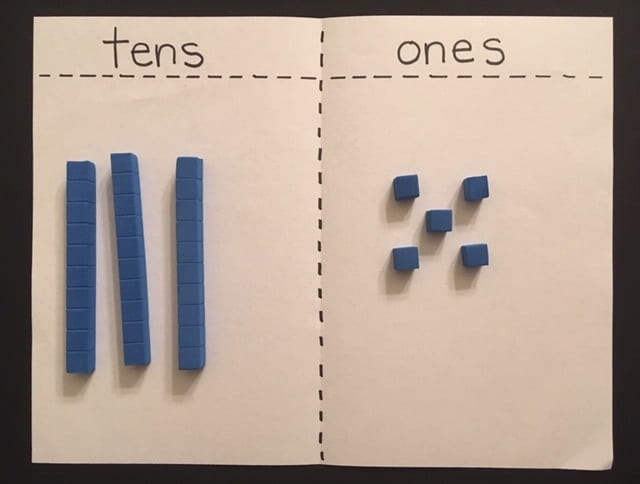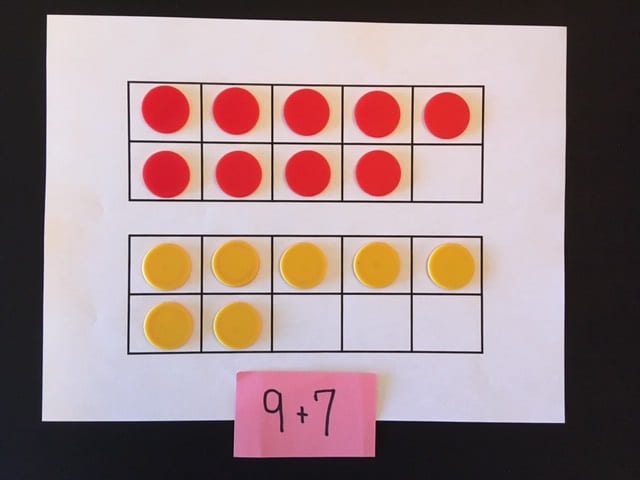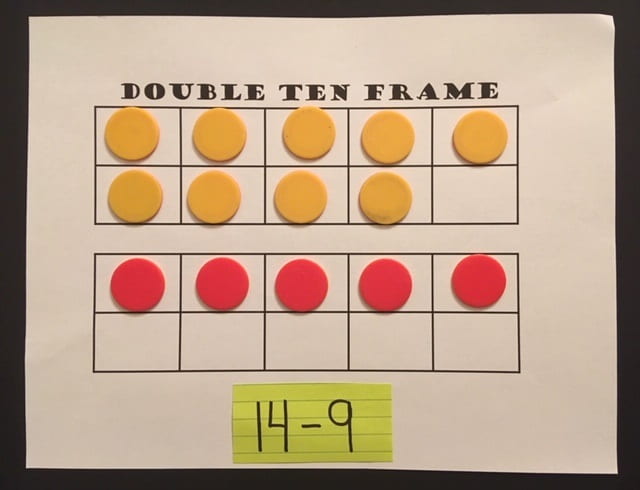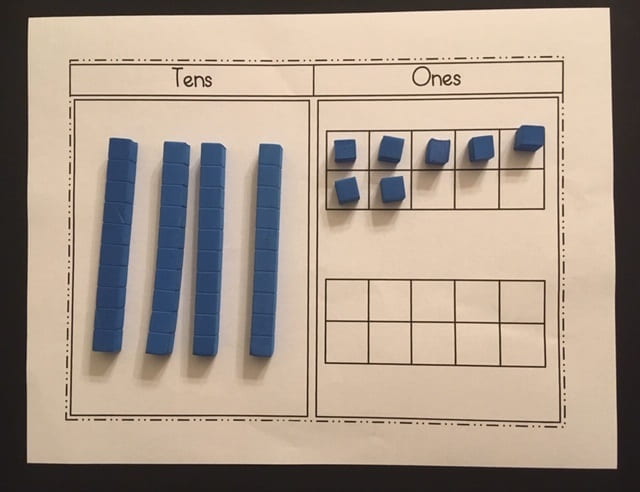by C. Elkins, OK Math and Reading Lady
Welcome back to Part 3 of my Ten Frame series. This will continue with some more ideas on using ten frames for addition and place value. Be sure to grab my free set of mini ten frame dot cards and Place value mat with ten frames to use with these activities.
Add 9:
How often do you see students counting their fingers, drawing tally marks, or other figures to add 9? But what if they could visualize and conceptualize adding 9 is almost like adding ten, but one less? This is where the ten frame comes in handy.
- To be most efficient with adding 9, help students to add 10 (or a multiple of 10) to any single digit. Example: 10 + 7, 20 + 4, 50 + 8 . . .
- Show a problem such as 9 + 7 as part of your daily Number Talk. Observe and listen to how students are solving.
- Introduce this strategy by showing two ten frames – one with 7 and the other with 9. Check for quick recognition (subitizing) of these amounts on each ten frame.
- Move one counter from the ten frame with 7 to the ten frame with 9. This will complete it to a full ten frame. Then add 10 + 6 mentally.
- The purpose is for students to visualize that 9 is just one away from 10 and can be a more efficient strategy than using fingers or tally marks.
- Practice with several more +9 problems.
- For 3rd and up try mental math problems such as 25 + 9 or 63 + 9. Then how about problems like 54 + 19 (add 20 and take away one)?
- Can students now explain this strategy verbally?
Subtract 9:
- Let’s say you had the problem 14 -9. Show 2 ten frames, one with 10 and one with 4 to show 14.
- To subtract 9, focus on the full ten frame and show that removing 9 means almost all of them. Just 1 is left. I have illustrated this by using 2 color counters and turning the 9 over to a different color.
- Combine the 1 that is left with the 4 on the second ten frame to get the answer of 5.
- Looking at the number 14, I am moving the 1 left over to the one’s place (4 + 1 = 5). Therefore 14 – 9 = 5
- Start with 14 (red)
- Turn over 9 (yellow)
- Move the red together
Use of the ten frame provides a concrete method (moving counters around) and then easily moves to a pictorial method (pictures of dot cards). These experiences allow students to better process the abstract (numbers only) problems they will encounter.
Place Value Concepts:
- If you find you don’t have enough base ten blocks to go around, then the mini ten frames might be a good substitute for students to show their understanding of place value regarding tens and ones.
- Provide individual students (or pairs of students) a baggie of prepared tens frames. You would need 10 complete 10 frames and then 1 of each of the others (0-9).
- Using a blank tens/ones mat, state a 2 digit number such as 35. Show students the 3 represents how many 10’s there are (3) and the 5 represents how many 1’s (5). Place ten frames on the mat to illustrate.

35 — With mini ten frames
- Vary how you ask students to show amounts: Sometimes say, “Show me 35.” vs. “Show me 3 tens and 5 ones.” vs. “Show me 30 and 5.”
Variation of using base ten blocks with this place value mat:
- This place value mat (link above in opening paragraph) allows you to use your base ten blocks on the ten’s side and the units cubes on the one’s side, with one helpful difference.
- The ten frame template allows students to organize their ones as opposed to random placement when no ten frame is present. This helps students with number bonds and it really helps you, as the teacher who is observing, to determine immediately if the student placed the correct # of units.*
- With the examples shown (47), students can show the ones as 5 + 2 or 4 + 3.
- 47 = 4 tens, 7 ones
- Another way to show the ones
*Even without the use of this mat with printed ten-frame, I insist students show some type of organized placement of units cubes any time they are being used for some type of counting. Students can be creative with patterns that resemble domino or dice dots, ten frame configurations, equal rows, etc. Try it!!!

The ones cubes are organized!
Adding or Subtracting 2 digit numbers:
- Use a generic tens/ones mat and the mini ten frames so students can model problems such as these:
- 39 + 15
- 26 + 12
- Use the tens/ones mat (with ten frames). Utilize both ten frames in the one’s place for adding two 2-digit numbers.
- Students can use units cubes or counters for the one’s place for concrete experiences.

This shows 64 + 19
- Utilize some of the previously mentioned strategies for working with doubles, near doubles, 9, etc.
- Show regrouping: Example 82 – 7. Start with 82 (with all purple tens on the ten’s side). Since there aren’t enough ones to subtract 7, regroup by moving ten to the one’s place (shown in picture below). Critical step: Be sure to have students see that there are still 82 dots on the board (70 + 12). Now 7 can be removed (2 from the orange card and 5 from the purple card, which leaves 5). The answer would be 75.

- For pictorial practice, laminate the mats and students can draw in the pieces with dry-erase markers.
Counting coins:
Check out this free resource from one of my favorite math specialists (Math Coachs Corner):
Coin identification and value activity with ten frames
Have a great week! Let us know how using ten frames has helped your students!








